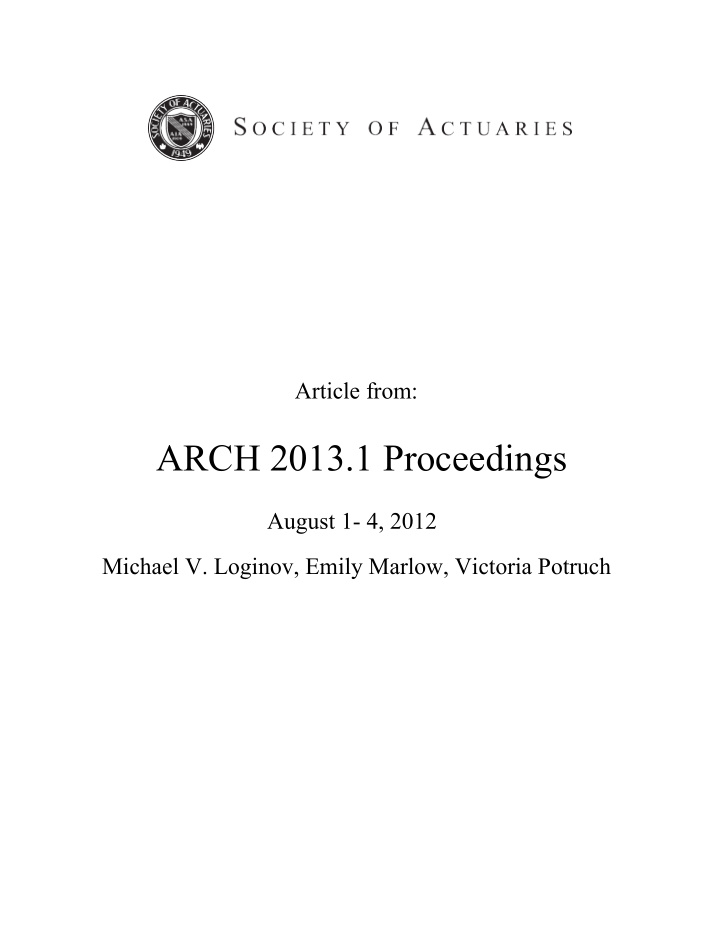



Article from: ARCH 2013.1 Proceedings August 1- 4, 2012 Michael V. Loginov, Emily Marlow, Victoria Potruch
PREDICTIVE MODELING IN HEALTHCARE COSTS USING REGRESSION TECHNIQUES Michael Loginov, Emily Marlow, Victoria Potruch University of California, Santa Barbara
Introduction ¨ Building a model that predicts an individual’s cost to an insurer
Introduction ¨ Building a model that predicts an individual’s cost to an insurer ¨ Goal: Determine future healthcare costs using prior costs, demographics, and diagnoses
Introduction ¨ Goal: Determine future healthcare costs using prior costs, demographics, and diagnoses • Accurate health insurance rate-setting
Introduction ¨ Goal: Determine future healthcare costs using prior costs, demographics, and diagnoses • Accurate health insurance rate-setting • Identify individuals for medical management
Introduction ¨ Goal: Determine future healthcare costs using prior costs, demographics, and diagnoses • Accurate health insurance rate-setting • Identify individuals for medical management • Measure risk for fund transfer between insurers in new health insurance exchange after 2014
Data ¨ Data set of health insurance claims from 2008 to 2009 ¨ 30,000 individuals ¨ 133 variables
Data
Data ¨ Numeric variables: age, total cost, categorical costs ¨ Binary variables: flags for hospital and PCP visits, flags for HCCs ¨ String variables: gender, self funded or fully insured
Data
Data ¨ Log transformation
Data
Data ¨ Log transformation ¨ Truncation
Data ¨ Log transformation ¨ Truncation ¨ Creation of “interaction” variables
Data ¨ Set of n=10,000 individuals is used to create the model ¨ Another sample of m=10,000 is used to test predictive power
Methods ¨ Linear regression: assume the data follows y= β₁x₁ ¡+ ¡β₂x₂ ¡+ ¡… ¡+ ¡β n x n ¡+ ¡N(0,σ²) ¡ ¡ ¨ y is an individual’s log year 2cost ¨ x k is the value of a parameter, such as age
Methods ¨ Linear regression: assume the data follows y= β₁x₁ ¡+ ¡β₂x₂ ¡+ ¡… ¡+ ¡β n x n ¡+ ¡N(0,σ²) ¡ ¡ ¨ y is an individual’s log year 2cost ¨ x k is the value of a parameter, such as age ¨ Build a model by estimating the coefficients β₁ ,…, β n and σ² with least squares estimates
Methods ¨ To reduce the number of predictors needed for the model we implement Lars , the use of least angle regression with the least absolute shrinkage and selection operator
Methods ¨ Least angle regression: creating a linear regression model one variable at a time • Standardize all variables • Choose the parameter that is most highly correlated with y, and perform simple linear regression with that one parameter
Methods ¨ Least angle regression: creating a linear regression model one variable at a time • Standardize all variables • Choose the parameter that is most highly correlated with y, and perform simple linear regression with that one parameter • Find the parameter most correlated with the residuals and repeat
Methods ¨ Lasso uses a constraint λ on the sum of the standardized regression coefficients: Maximize ∑(y-‑ŷ)² ¡subject ¡to ¡∑|β~| ¡≤ ¡λ ¡ ¨ ŷ ¡is ¡the ¡predicted ¡value ¡of ¡y ¡using ¡the ¡esJmates ¡of ¡ β₁ ,…, β n ¨ β~ coefficients are standardized ¨ λ ¡is ¡arbitrary ¡
Methods
Methods ¨ Mallow’s C p statistic is used to choose k, the number of steps we take: C p = (1/ σˆ²)∑(y-‑ŷ k )² ¡-‑ ¡n ¡+ ¡2k ¡ ¡ ¨ We ¡choose ¡k ¡such ¡that ¡ C p ¡does ¡not ¡significantly ¡ decrease ¡when ¡k ¡is ¡increased
Methods
Methods ¨ Models are compared using adjusted R ² ¡and ¡ MSE ¡ ¨ Adjusted ¡R² ¡measures ¡goodness-‑of-‑fit ¡ ¨ MSE ¡measures ¡predicJve ¡power ¡
Results ¨ Ran 4 models to compare • Model 1: Linear regression with age, gender, year 1 log cost • Model 2: Linear regression with all year 1 non- health data • Model 3: Linear regression with all data available in year 1 • Model 4: Lars with all data available in year 1
Results
Results
Results Adjusted R ² Model Number of Variables MSE Model 1 3 0.3721 6.1738 Model 2 31 0.4040 5.9146 Model 3 131 0.4069 5.8897 Model 4 13 0.4027 5.8492 ¨ Models 3 and 4 are comparable ¨ Model 4 uses 118 less variables ¨ We use model 4 to draw conclusions
Results Predictor Effect on Cost Age +0.65% per year Male Flag -23.73% Year 1 Cost +51.24% Male Age 15-24 Flag -20.94% Male Age 25-44 Flag -23.78% Year 1 Pharmacy Cost +8.75% Year 1 Inpatient Cost -2.38% Year 1 ER Visit Flag +8.06% Year 1 PCP Visit Flag +6.66% Year 1 PCP Visit Count +6.47% HCC 19: Diabetes +28.83% HCC 22: Metabolic/Endocrine +22.23% HCC 91 Hypertension +6.36%
Acknowledgements ¨ In order to conduct this research we used the open source statistical software R with the package lars which includes LAR and lasso ¨ We used LATEX to produce our paper ¨ We would like to thank our faculty advisors, Ian Duncan, Raya Feldman, and Mike Ludkovski for their assistance, their guidance, and their enthusiasm for this research

Recommend
More recommend